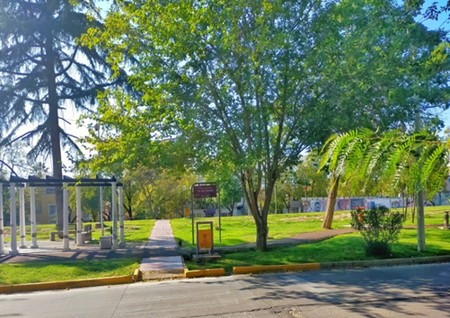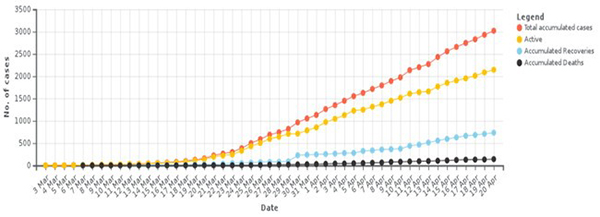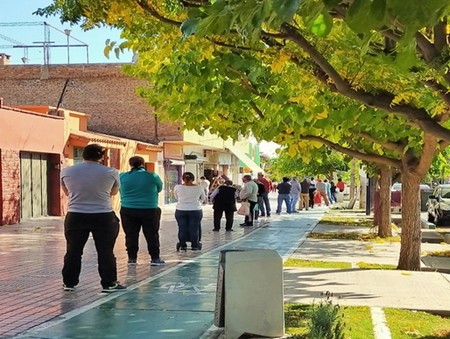【20-12】アルゼンチンにおけるCOVID-19の状況:概要分析
2020年5月18日 Ami Watanabe(さくらサイエンスプラン(SSP)同窓生)
科学技術振興機構(JST)中国総合研究・さくらサイエンスセンター(CRSC)では、2014年度より日本・アジア青少年サイエンス交流事業「さくらサイエンスプラン(SSP)」を実施し、科学技術交流を通じてわが国とアジアを中心とした各国・地域との連携・協力関係を深めてまいりました。各種報道の通り、現在、世界中で新型コロナウイルス感染症の流行が拡大しておりますが、本コーナーでは「さくらサイエンスプラン」に参加している各国・地域の関係機関・関係者より現地の新型コロナウイルス感染症について、その状況や対策等をリポートします。
中国武漢でのコロナウイルスの最初の症例は、2019年末にWHOに報告されました。その瞬間から全ての国が新たなグローバルな問題、つまり多数の人々が感染し、死に至らしめる新ウイルス蔓延に対する警戒状態に置かれました。
2か月後、新コロナウイルスがアルゼンチンにやってきました。
我が国での最初の症例は2020年3月3日に確認された、イタリアを訪れた43歳の男性でした。翌日、いくつかの州で疑わしい事件が発表されました。 3月5日には、すでに2番目の症例が確認されました。症例数は増加し、残念なことに3月7日にアルゼンチンでCOVID-19による初めての死亡例が報告されました。
世界中で発生していたCOVID-19の状況に直面し、ラテンアメリカに、そしてアルゼンチンにやってくる前に、予防策を講じられていました。大統領は3月16日に学校の閉鎖を命じ、3月20日には強制検疫を行いました。(その日までに158人が感染し、3人が死亡していました) 1週間後の3月27日、政府は国境、空港、港を閉鎖しました。

閑散とした公園
サッカー試合の中止、在宅勤務の推進、衛生対策の強化、マスクの必須使用、研究プロジェクトへの融資、急を要する家庭への経済的支援などが対策として追加されました。
これらの対策の目的はウイルスの蔓延を最小限に抑え、人の密集と医療崩壊を防ぎ、米国、スペイン、またはイタリアで起こっている事態を防ぎ、なんとか感染曲線を平坦化することです。現在、アルゼンチンは直線的な推移を遂げていて、これまでに計3,031人が感染、142人が死亡という状況で、これまでの対策が効果的であることが示されています。

対策は適切であったにもかかわらず、ある領域での欠陥を示しています。問題は人口の最も脆弱な地域に何が起こるか、そこに本当の問題があります。
隔離政策は、ほとんどの経済活動の停止をもたらしました。多くの人々にとって隔離期間中に家を出ないことは不可能です。さらに、最も脆弱な地域では道端に住んでいる人もいれば、過密状態で住んでいる人もいます。また、一部の家のインフラの問題、水道や衛生設備の不足、予防策として強調されている手洗いなどの基本的な衛生対策が不十分な状態です。

ソーシャルディスタンス
政府は育児手当や非正規労働者のための緊急手当($ 10,000アルゼンチンペソ)などの支払いを強化していますが、基本的な生活を送るのに十分ではない家庭も存在します。
INDEC(国立統計調査機関)によると、2019年末の時点で、アルゼンチンの人口の35.5%が貧困状態にあり、緊急事態発生時にその数は増加すると予測されています。
結論として、政府は適切かつ早期の衛生対策を講じていますが、この状況は以前から存在していた社会経済ギャップをますます露呈させ、深刻にしています。衛生対策の実行を強制することにより、経済発展に更にブレーキをかけている状況です。
私たちは世界中で今、起こっていることから学び、英知を得ることができると私は願っています。私たちは時間が鍵であることを学びました。この状況は国の中で最も脆弱なエリアを考慮に入れ、全国民に平等に届けられる早期の対策を講じて、将来のパンデミック発生時には有効な実例となるでしょう。
私たちは目に見えない敵と戦っています。このような状況下でより強くなるためには、私たちは連帯し、社会的責任を共有しながら団結していくことが不可欠です。(2020年4月20日)
※本稿はさくらサイエンスプラン同窓生からの寄稿文を中国総合研究・さくらサイエンスセンターが日本語訳したものである。
●英文オリジナル
Situation of COVID-19 in Argentina: brief analysis
The first cases of coronavirus in Wuhan, China, were reported to the WHO at the end of 2019. From that moment, all countries were put on alert against a new global challenge: prevent the spread of a new virus, which was causing thousands of infected and dead.
2 months later, the new coronavirus arrived in Argentina.
The first case in our country was confirmed on March 3, 2020. It was a 43-year-old man who had visited Italy. The next day, suspicious cases were announced in some provinces. In March 5, we already had the second confirmed case. While the cases increased, unfortunately on March 7 we reported the first death of COVID-19 in Argentina.
Facing the situation of COVID-19 that was being experienced in the world, before it arrived in Latin America and from there to Argentina, we had time to take early prevention measures. Consequently, the President of Argentina decreed the closure of schools on March 16, and the mandatory quarantine on March 20, until that date with 158 infected and 3 dead. A week later, on March 27, the government closed the national borders, airports, and seaports.
Cancellation of football matches, promotion of home office, reinforcement of hygiene measures, mandatory use of mask, financing of research projects, payment of emergency family income, were other measures that were added along the way.
The aim of these measures taken is to minimize the circulation of the virus, prevent the crowding of people and the collapse of hospitals, in order to prevent what happening in United States, Spain or Italy, and somehow manage to flatten the infection curve. Currently, Argentina is experiencing linear growth, with a total of 3031 infected and 142 deaths to date, indicating that the measures taken are being effective.
Despite the measures are proper, it has showed the deficiencies we have in certain areas.
The question is what happens to the most vulnerable areas of the population?
Here is the real problem:
Isolation policy in response to the health crisis resulted in the stoppage of most work activities. For many families who live day by day, not leaving their homes during the quarantine is impossible. In addition, in the most vulnerable areas, some people live practically on the streets, others live in overcrowded conditions, where social isolation is not possible, also the infrastructure problems of some homes, lack of running water and sanitary systems, making impossible to take the basic hygiene measures such as hand washing, which is strongly emphasized as a preventive measure.
Despite the government is reinforcing the payment of social plans, such as the Universal Child Allowance or the Emergency Family Income (sum of $ 10,000 pesos argentinos) for informal workers, in some cases they are not enough to guarantee basic needs.
According to INDEC (National Institute of Statistics and Census), at the end of 2019, 35.5% of the Argentina population was poor and the number will increase during the health emergency.
In conclusion, although Argentina has taken appropriate and early sanitary measures, this situation is increasingly exposing and deepening the socioeconomic gap, which has already existed before, but it is this situation that it forces the taking of sanitary measures that generate a brake on economic development, further deepening poverty.
I hope that we can learn and become aware of what is being experienced worldwide. We learned that time is the key. This situation will serve as an example for us to face future pandemics, taking early measures that take into account the most vulnerable areas of the population and be able to reach the entire population equally.
We are facing an invisible enemy. It is essential to be united as a society, where solidarity and social responsibility prevail, in order to emerge stronger from this situation.
Ami Watanabe
Participant of Sakura Science Project 2020